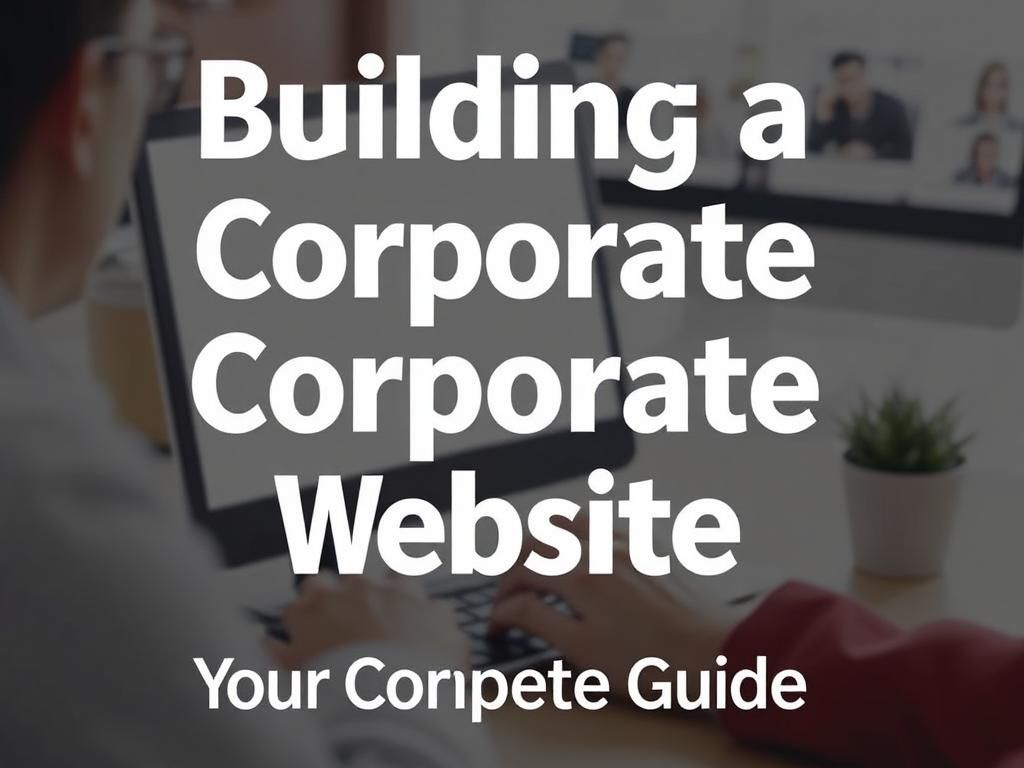In today’s digital landscape, building a corporate website is not just an option—it’s a necessity. A corporate website serves as the virtual storefront for businesses, encapsulating what they stand for while reaching a broader audience. By establishing a brand presence online, businesses enhance their credibility and actively participate in the global marketplace. A well-crafted website not only communicates essential information about products and services but also serves as a powerful marketing tool that drives engagement and conversions.
This article aims to guide businesses through the intricate process of building a corporate website, emphasizing key considerations and best practices to ensure success. From defining the goals of your website to launching it effectively, every step is crucial in creating an impactful online presence.
Defining the Goals of Your Corporate Website
Identifying Target Audience
Understanding your target audience is paramount when building a corporate website. Identifying demographics and psychographics helps tailor the website to meet user needs effectively. Analyze factors such as age, gender, location, interests, and online behavior to create relevant content and design. Knowing your audience allows for better engagement strategies, which can lead to increased conversions.
Setting Clear Objectives
Once you’ve identified your target audience, it’s time to set clear objectives for your corporate website. These may include:
- Increase brand awareness
- Generate leads and conversions
- Provide comprehensive information about products/services
- Facilitate customer engagement
Defining these objectives will not only inform your design choices but also guide your content strategy.
Planning Your Website Structure
Creating a Sitemap
A well-structured sitemap is essential in the process of building a corporate website. It helps visualize the hierarchical organization of content and ensures that users can navigate seamlessly through your site. Essential pages to include are:
- Home
- About Us
- Services/Products
- Blog
- Contact Us
User Journey Mapping
Mapping the user journey involves understanding how visitors navigate your site. By identifying key touchpoints and calls to action (CTAs), you can create pathways that lead to desired outcomes, such as filling out a contact form or making a purchase. Thorough user journey mapping ensures that your site caters to the audience’s needs effectively.
Design and User Experience (UX)
Importance of a Professional Design
The design of your corporate website plays a vital role in forming first impressions. A professional layout not only reflects your brand’s identity but also helps build trust. Consider elements such as color schemes, fonts, and logos as they contribute significantly to your website’s overall aesthetic and functionality.
Responsive Design
In an era where mobile devices dominate, ensuring responsive design is crucial when building a corporate website. Your site must be easily navigable on smartphones and tablets, and site speed is essential for retaining visitors. Tools like Google’s PageSpeed Insights can help assess your site’s performance.

UX Best Practices
To provide an optimal user experience, several best practices should be followed:
- Intuitive navigation—make it easy for users to find what they need.
- Consistency in design elements—use familiar icons and styles.
- Accessibility features—consider all users, including those with disabilities.
Developing Content
Crafting Engaging Copy
The content on your corporate website can make or break its success. Establish a brand voice that resonates with your audience while embracing SEO best practices. Use relevant keywords naturally throughout the text to enhance visibility and engagement.
Visual Content Integration
Utilizing images, videos, and infographics can significantly enhance user engagement. Visual content breaks up text and can communicate complex ideas more effectively than words alone. Aim for a balanced combination of text and visuals for optimal user experience.
Regular Updates and Blog
Maintaining fresh content is vital for SEO and audience engagement. Regularly updating your website and integrating a blog component allows you to share industry news, insights, and topics of interest to your audience. This practice helps position your brand as a thought leader in your industry.
Choosing the Right Tools and Technologies
Selecting a Domain Name and Hosting
Your domain name is a critical aspect of your online identity. It should be memorable, reflective of your brand, and easy to spell. When it comes to hosting, you have various options—shared, virtual private servers (VPS), or dedicated hosting. Evaluate your needs carefully to choose the right solution for your website.
Content Management Systems (CMS)
Choosing the right content management system is essential for ease of use and flexibility. Popular platforms like WordPress, Wix, and Squarespace offer unique features. WordPress, for example, boasts a large plugin ecosystem while Wix provides intuitive drag-and-drop functionality. Consider the advantages and disadvantages of each to find a fit for your needs.
Utilizing Tools for SEO and Analytics
Effective building a corporate website also includes implementing SEO strategies early on. Use keyword research tools like SEMrush or Ahrefs to find relevant keywords. Additionally, Google Analytics is invaluable for tracking your website’s performance and gaining insights into user behavior.
Implementing SEO Best Practices

On-Page SEO Techniques
On-page SEO is crucial for gaining visibility in search engines. Essential practices include optimizing title tags, writing compelling meta descriptions, and effectively structuring headers. Internal linking strategies also enhance user experience and allow search engines to crawl your site more effectively.
Off-Page SEO Considerations
Building backlinks is an essential part of enhancing your website’s authority online. Engage in social media activities and collaborate with industry influencers to encourage backlinks. Social media platforms can broaden your reach and drive more traffic to your corporate website.
Technical SEO Essentials
Technical SEO involves backend optimizations that enhance performance and user experience. Key elements include site speed optimization, mobile responsiveness, and structured data. Employing tools like Google’s Structured Data Testing Tool can ensure your site meets these critical standards.
Launching the Corporate Website
Pre-Launch Checklist
Prior to launching your corporate website, thorough testing is essential. Use a comprehensive pre-launch checklist that includes:
- Testing all links and forms
- Checking for cross-browser compatibility
- Ensuring that all features work as intended
Effective Launch Strategies
Once testing is complete, plan an effective launch strategy. Announce your website launch on social media platforms to reach your audience immediately. Consider sending press releases to relevant industry publications and executing email marketing campaigns to inform subscribers of the new site.
Post-Launch Activities
Monitoring Performance
After launching, monitoring your website’s performance is critical. Set up analytics dashboards to track key performance indicators (KPIs) such as visitor numbers, bounce rates, and conversion rates. Regularly analyzing these metrics will allow you to make informed decisions for ongoing improvements.
Updating and Maintaining Content
Ongoing maintenance requires regular content audits and updates based on user feedback. Ensuring that the content remains relevant and accurate is essential for retaining user trust and optimizing for search engines.
Conclusion
Recap of Key Points
The journey of building a corporate website is multifaceted, emphasizing the importance of thoughtful design and content while highlighting the necessity of ongoing maintenance for sustained success.
Final Thoughts
Investing in a well-structured corporate website is an invaluable step for any business striving for success in the digital age. With the right strategy, businesses can significantly enhance their online presence, ultimately leading to increased engagement and sales. For further reading and assistance, consider resources available on sites like Moz and local digital marketing firms.
| Element | Description | Best Practices |
|---|---|---|
| Target Audience | Demographics and psychographics that inform content strategy. | Conduct thorough research to tailor your website. |
| Content Management | Selecting a suitable CMS for flexibility and usability. | Evaluate pros and cons of options like WordPress and Wix. |
| SEO Strategies | On-page, off-page, and technical SEO for visibility. | Regularly update content and monitor analytics. |
| Design | Professional, responsive design that reflects brand identity. | Prioritize speed and engaging user experience. |
FAQs
- What is the most important aspect of a corporate website?
The most crucial aspect is usability and accessibility, ensuring that visitors can easily find information and navigate the site. - How often should I update my website content?
Regular updates are recommended, ideally at least once a month, to keep content fresh and relevant. - What are the best practices for SEO?
Focus on keyword optimization, creating high-quality content, and ensuring fast load times. - Do I need a blog on my corporate website?
Having a blog can significantly enhance SEO and provide valuable content to your audience. - Can I build my website without coding?
Yes, platforms like Wix or Squarespace offer user-friendly interfaces that do not require coding skills. - What is a Content Management System (CMS)?
A CMS is a software application that allows users to create, edit, and manage digital content without extensive coding knowledge. - Is mobile optimization necessary?
Absolutely. With the majority of web traffic coming from mobile devices, ensuring your website is mobile-friendly is essential. - How can I improve my site’s loading speed?
Optimize images, use a content delivery network (CDN), and minimize code to improve loading times. - What role does analytics play in website success?
Analytics provide insights into user behavior, allowing you to make data-driven decisions for improvements. - What should I include in my website’s footer?
Include essential information such as contact details, social media links, and a privacy policy.